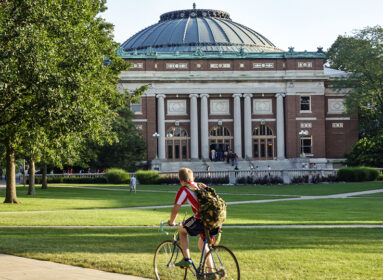In 1925, Fanny Goldstein, a librarian at the West End Branch of the Boston Public Library, set up an exhibit of Judaic books and used it as a focus for what she called Jewish Book Week. In 1927, with the assistance of Rabbi S. Felix Mendelsohn of Chicago, the event was adopted by communities around the country.
During its first fifteen years, the annual date of the program coincided with the holiday of Lag B’Omer, traditionally regarded as a scholars’ festival. In 1940, the event was moved to the days and weeks preceding Chanukah in order to promote the purchase of books of Jewish content as holiday gifts. Over the years, Jewish Book Week became so popular and so filled with activities that it was extended to a one-month period in 1943.
Today, Jewish Book Month remains an annual event coordinated by the Jewish Book Council, dedicated to the celebration of Jewish books. Because it is observed during the month preceding Chanukah, the exact date changes each year. To find out more about the Jewish Book Council and the programs and items it offers to help in the celebration of Jewish Book Month visit www.jewishbookcouncil.org.
The Ledger begins its month-long celebration of Jewish Book Month with a look by Ledger staff writer Cindy Mindell at several exciting new books on Jewish topics and by Jewish authors. This issue features books by Daniel Asa Rose, Lorrie Greenhouse Gardella, Robert Gillette and Andi Rosenthal.
~~~~~~~~~~~~~~~~~~~~~~~~~~~~~~~~~~~~~~~~~~~~~~~~~~~~~~~~~~
Daniel Asa Rose, Family matters
Rowayton native Daniel Asa Rose was already an award-winning fiction-writer when he decided to find out what had happened to his mother’s family during the Holocaust. In 1992, as his marriage was breaking up, he took two of his four sons to Belgium, armed only with his uncle’s old diary. A decade later, he published “Hiding Places: A Father and His Sons Retrace Their Family’s Escape from the Holocaust” (Three Rivers Press, 2002). The book Publishers Weekly called “brilliant and unconventional” weaves the search for the hiding places that saved Rose’s family in World War II with memories of his own hiding places as a kid growing up Jewish in a Connecticut suburb, circa 1950.
“I wanted to give my kids a sense of their larger family, that is, their Jewish family, after our original one was shattered,” he says. The journey transformed Rose, who had always felt alienated from his Jewish roots. “Writing the book propelled me,” he says. “I had come to that quest very ambivalent about my Jewishness, and the 10 years I spent writing the book was the largest canvas of my life. It incorporated many themes – the Holocaust, my family, my children, my own childhood, identity.
When I came out of the experience, I felt steeped in more than I had bargained for.”
As soon as “Hiding Places” came out, Rose was asked to join The Forward as arts and culture editor, a position he held for three years.
“My mother would have been shaking her head,” he says of the job at “the red-hot center” of Jewish cultural life. “I was the most rebellious of her children, which, it turns out, is a very Jewish thing to be,” he says. “The whole idea of turning your back on the religion and scoffing at it – I was following a pious tradition. Judaism doesn’t discourage that search but tolerates and maybe even encourages it, and welcomes you back. It says, ‘Here we are; we’re ready to embrace you.’”
Rose has long explored the subject of family in his writing. His 1987 novel, “Flipping for It” (St. Martin’s Press), is a dark comedy based on his first divorce. After “Hiding Places” and the breakup of his family, Rose was just about to head back into the New Mexico desert to chronicle a near-death experience from his 20s. “But I got a call from Larry, my black-sheep cousin, who said he needed help getting a kidney,” he says. “So I took a detour to China.”
“Larry’s Kidney” (William Morrow, 2009) is another quest, this time to save a life. “I find the kidney by throwing myself upon the mercy of a Jewish congregation in Beijing,” Rose says. “In the middle of services, I stand up and say, ‘I’m Daniel Asa Rose from the United States, and my cousin Larry needs a kidney, and unless you guys help me, we’ve got a real catastrophe on our hands. You can perform a real mitzvah here.’ They look at this guy and don’t know what to make of me; I’m wearing a Panama hat instead of a yarmulke, and I’m in shorts. But they came together and provided me with the link that led me to Larry’s kidney. I found out later that the congregation was conducting ‘Mi Sheberach’ for him until he had gotten through the transplant.”
The Hollywood film version of “Larry’s Kidney” is currently in pre-production. For the last two years, Rose has been in the New Mexico desert a lot, working on his memoir of “the miraculous car crash.” The trips have helped him reorient after his family’s breakup. Through his writing, he also continues to reclaim pieces of identity.
“Now I’m more deeply related to Jews,” he says. “It’s a humanistic thing: I don’t go to services any more often — though I was in Italy over the High Holidays and went to services in Rome and Florence. But that’s not where my spiritual moments take place. Rather, they happen in the woods when I’m on my bike, or with my children, or in the desert when I’m alone with God. I’m real aware of my Jewish connection with God.”
~~~~~~~~~~~~~~~~~~~~~~~~~~~~~~~~~~~~~~~~~~~~~~~~~~~~~~~~~
Lorrie Greenhouse Gardella, “Social Work through the Holocaust”
Lorrie Greenhouse Gardella is associate dean and professor of social work in the School of Graduate and Professional Studies at Saint Joseph College in West Hartford.
A resident of Hamden, she is the author of a just-published biography of Louis Lowy, a Holocaust survivor who became one of the best-known social workers and gerontologists in the U.S. The book is the first published account of Lowy’s life.
Louis Lowy almost never spoke publicly about his experiences during the war, Gardella says. But at the end of his life, in 1991, he recorded 16 hours of an oral narrative that explored how his activities during and after the Holocaust shaped his decision to become a social worker. Those experiences included his work as a volunteer youth leader at Terezin and an indigenous leader in the Jewish Displaced Persons Camp in Deggendorf, Germany.
Lowy, who had taught at the Boston University School of Social Work from 1947 to 1985, intended to use the oral history to write a journal article, “The Making of a Social Worker,” but he died before he could complete the task. His widow, Ditta, and several former BU colleagues approached Gardella, who had written extensively on social-work history. “If all I had had to work with was the oral narrative, the outcome probably would have been a journal article,” Gardella says. “But I had the tremendous good fortune to interview three of the youth whom Lowy had cared for in the Terezin Ghetto, including his wife, all now in their 80s. I realized that there was much, much more to say.
The resulting book, “The Life and Thought of Louis Lowy: Social Work Through the Holocaust,” was published last month by Syracuse University Press and introduced on Nov. 14 at a special event at Boston University.
The book is based on four independent accounts by four different eye-witnesses to the same events. “In Holocaust research, that’s very unusual,” Gardella says. “Eye-witness testimonies are often the best sources of information for historians, so we were tremendously fortunate to have four narratives of Lowy’s activities.”
Lowy is among many important social workers and other human-services professionals exiled from Germany in the ‘30s or who survived the war. Several were involved in the resistance movements in Poland and France. “Social-work values were as contrary to National Socialism as could be,” Gardella says. “The Nazis destroyed social work in the countries they occupied because so many were Jewish or Communist or both, so practically none of them were left after the war.” In fact, a 1946 census of Displaced Persons by the United Nations Relief and Rehabilitation Administration (UNRRA) identified only 24 social workers among Holocaust survivors. “The roster of social-work exiles and survivors reads like a ‘Who’s Who’ of 20th-century American social workers, including, to name a few, Werner Boehm, Hans Falck, Sophie Freud, Alex Gitterman, Gisela Konopka, Henry Maier, Kurt Reichert, Maria Hirsch Rosenbloom, and Louis Lowy.”
Born in Munich in 1920, Louis Lowy immigrated with his family to Prague in 1936, where he studied for one year at Charles University. A student of philosophy and philology, he had set out to become a professor of philosophy. He was sent to Terezin in 1942, at age 22. While there, Lowy defied the law and secretly taught English, philosophy, and history in the camp youth home. “I found biographies and memoirs of other survivors talking about studying with Lowy,” Gardella says. “They talked about how he gave them hope by telling them that the Allies would win the war and everyone would need to know English.” When Terezin was used for propaganda purposes, and cultural activities were allowed, Lowy directed children’s plays as a way of teaching, Gardella says. Two of the three former pupils Gardella interviewed for her book became social workers after the war.
Following liberation from Terezin, Lowy spent a year in the Jewish Displaced Persons Camp in Deggendorf, Germany. “The Jews who survived called themselves ‘the small remnant,’ or ‘the rest who remained,’ but were labeled ‘stateless or non-repatriable Jews’ by the U.S. government,” Gardella says. “Many had been liberated from death camps and concentration camps and though the Allies had been making repatriation plans for refugees since 1943, had not thought about what to do with the Jews. Some of the countries thought the Jews should go back to the countries they came from, but no one really knew what to do and for some months they were actually left as prisoners behind barbed wire in the concentration camps that had been liberated.”
President Truman directed Gen. Eisenhower, then the Supreme Allied Commander in Europe, to address the situation. Several Jewish Displaced Persons camps were founded specifically for the “stateless or non-repatriable Jews,” many of whom were stuck there for years, Gardella says, some even until 1949.
As early as June 1945, liberated Jews began to organize, creating the Munich-based Central Committee of the Liberated Jews in the U.S. Zone of Germany as the official legal representative body to the U.S. military. The committee immediately established a historical commission to try to document what had happened during the war, as well as Jewish life before the war.
Though administered by UNRRA, each Jewish DP camp had its own indigenous leadership and independent government. At 25, Lowy was elected as the indigenous leader of the Deggendorf camp. Many of the residents, mostly survivors of Terezin, were experienced professionals in law and government administration, and Lowy drew on their expertise to create an elaborate governmental structure, Gardella says. “A lot of the older people in the camp did not want leadership roles because they were sick, heartbroken, or afraid to deal with people in uniform,” she says.
Lowy came to the U.S. after the war and earned a BA and MA at Boston University and a PhD at Harvard before joining the social-work faculty at BU. He also became a noted gerontologist, and considered his experience at Deggendorf as his first brush with gerontology, Gardella says. “He was particularly sensitive to the interdependence of generations: young people have a responsibility to older people, but older people are valuable resources for the young.”
Every summer for 20 years, Lowy worked with other exiles and survivors to help restore social work and social-work education in in Germany and other formerly Nazi-occupied countries.
In 1978, Lowy wrote, “Before the War, I was a student in Prague, studying philology and philosophy. After surviving the Holocaust, I decided to become a social worker, because I found in this field an opportunity to work on behalf of social justice and to cope with social issues.”
“The big shock in my research, one of the things that amazed me, was how ineffective health and human service workers were in trying to help the Jewish refugees who had survived, including the Jewish charities and relief organizations,” Gardella says. “They did a terrible job, both in Europe and in the U.S. Very often, relief workers and social workers and psychiatrists did not speak the languages of the survivors so they couldn’t communicate. When they could communicate, they very often couldn’t believe the stories and said that the survivors were lying or were complicit and somehow guilty, or that the stories were irrelevant to the survivors’ future. This made me think, are we doing a better job educating health and human services workers today? Are our students doing any better with refugees who are their clients than those in the 1940s and ‘50s?”
Gardella, a West Haven native, was first introduced to social work during high school, when she volunteered the at West Haven Community House. After earning degrees in law and social work, she worked as a consultant in children’s law and as a social worker with the elderly and with adults with developmental disabilities. She has spent most of her professional life in higher education. Before embarking on the Lowy biography, she had done research in various areas related to cultural competence and educational access, but had developed a particular interest in social-work history. “It has been a huge honor to have the opportunity to work on this project,” she says of the book. “I’ve worked on it for years and it has been the highlight of my career so far.”
Among the early responses to the book was a letter from Germany, that arrived on Nov. 9, the 73rd anniversary of Kristallnacht. Signed by 30 students from two German schools of social work, the letter described the joint Kristallnacht commemoration held by the schools and congratulated Gardella on her book. The signees also pledged that, as social workers, they would uphold the values of their profession and never allow the Night of Broken Glass and its aftermath to happen again.
~~~~~~~~~~~~~~~~~~~~~~~~~~~~~~~~~~~~~~~~~~~~~~~~~~~~~~~~~
Robert Gillette, The Virginia Plan
Robert H. Gillette, who grew up in Fairfield and became a popular teacher in Fairfield’s high schools, is the author of the newly published book “The Virginia Plan,” (The History Press, 2011), which tells the true story of the heroic efforts of William B. Thalhimer, a department store owner in Richmond, VA., who saved the lives of dozens of young Jewish students in Nazi Germany. Thalhimer rescued the students at Gross Breesen Institute, an agricultural science school by transporting them to Hyde Farmlands in Burkeville, Vir. The book tells the remarkable history of Thalhimer’s rescue mission and the struggle of the new refugees to make a new home in rural America.
A former adjunct professor in the Graduate School of Education & Allied Professions at Fairfield University, Gillette’s roots in Fairfield are deep. He attended Grasmere School and Roger Ludlowe High School, and taught English at Andrew Warde High School and Fairfield High School for 30 years, until his retirement in 1999. During that time, he received numerous awards, including “Teacher of the Year” three times.
Gilette served as the director of religious education at Congregation B’nai Israel in Bridgeport for 27 years and as a lecturer at Sacred Heart University. After relocating to Lynchburg, Vir. with his wife Marsha in 2004, Gillette began writing. His first book, “A Paddler’s Guide to Prince Edward Island,” was published in 2006.
“The Virginia Plan” is the product of years of extensive research, begun after Gillette first learned about Thalhimer and Hyde Farmlands from his daughter-in-law in 2006. In the words of the foreword to the book written by Thalhimer’s great-granddaughter Elizabeth Smartt, “Set during a time of unspeakable tragedy and human failing, the Hyde Farmlands story invokes hope, spirit and something that Gramps called ‘stick-to-it-iveness.’ It is a ray of light shining through the darkest part of the attic. Thanks to Bob Gillette, it is now once again illuminated.”
~~~~~~~~~~~~~~~~~~~~~~~~~~~~~~~~~~~~~~~~~~~~~~~~~~~~~~~~
Andi Rosenthal, Mysticism, catastrophe, and identity
Andi Rosenthal was a graduate student in medieval literature and creative writing at Temple University when she was first captivated by the writings of female religious mystics. Among them were Julian of Norwich and Margery Kempe, both pioneering fourteenth century authors in the English-speaking world.
“Their writings reminded me a lot of Jewish mysticism, the ecstatic relationship to God that the sages teach about,” says Rosenthal, who lives in Greenwich. “I was so amazed that this also existed in a feminist tradition, which in many cases is inaccessible, and that these women’s voices had been preserved.”
After graduating, Rosenthal carried that fascination with her. But she was also enchanted by another genre typical of the Middle Ages: the secret diary. Ten years ago, while working as associate director of communications at the Museum of Jewish Heritage in Manhattan, she used the idea of a fictional secret diary as the basis of her first novel, “The Bookseller’s Sonnets” (O-Books, 2010).
The plot begins with the writings of Margaret, the actual eldest daughter of St. Thomas More. It was Rosenthal’s mother, a scholar of literature, sociology, and criminal justice, who suggested Margaret.
“It’s generally believed that Margaret was a prolific writer whose work simply didn’t survive,” Rosenthal says. “But right after her death, her husband suddenly produced copious writings in his own name.” The notion of Margaret as author of secret diaries didn’t seem far-fetched.
In the book, the diary appears anonymously on the desk of Jill Levin, senior curator at the Museum of Jewish Heritage. The plot follows Levin as she and her colleagues try to authenticate the work, aided by letters from the donor, who turns out to be a Holocaust survivor. Rosenthal guides the narrative with two questions: What is a Holocaust survivor doing with the diary? What does the diary have to do with the Holocaust and Jewish identity?
Rosenthal is no stranger to the personal journey. The child of a Catholic mother and Jewish father, she found Judaism on her own and converted in 2002. Now an outreach fellow at the Larchmont Temple in New York and director of communications at Temple Sholom in Greenwich, she has been speaking about her book to audiences across the country over the past year.
“It’s become part of a conversation that the Jewish community is starting to have,” she says. “Is fear of assimilation enough of a motivator for the Jewish community? So many people I know now have Jewish families like my own, which have some relationship — by marriage, by grandchildren, by so many means – to people of other faith traditions. And it is really hard to sustain the argument that loving or trusting or building a relationship with ‘the other’ is destroying us. It is counter to everything that is best about our community, and what is most meaningful about being Jewish. Jews have traveled with the mixed multitude since biblical times; we have lived in every country among every ‘other,’ and through these relationships, we have discovered blessings in every culture that we have made uniquely our own.”
In her role at Larchmont Temple, Rosenthal works with people on the path to Judaism and helps others who are not converting but who are involved in interfaith relationships and seeking a place in the congregation. She will be speaking at the Union for Reform Judaism Biennial in December, on the topic of “Creating a Culture of Welcome: Conversion as a Community Building Tool.”
“The Bookseller’s Sonnets” moves the discussion of Jewish identity from the Holocaust to assimilation, widely regarded as the current threat to Judaism. “One concern raised in the book is, now that we’ve survived the Holocaust and now that Jews are intermarrying and we fear this loss all over again, what now?” she says. “To have the roots of your faith based in catastrophe or fear of catastrophe is tremendously challenging. I don’t think that isolation is the answer, because we have never really been isolated. And if someone like me can grow up with literally no exposure to Judaism, with nothing but my last name to go on, then it is up to our community to help others like me to cultivate the spark and the connection to Jewish life, however tenuous. Assimilation does not automatically spell disaster if we can encourage and strengthen those threads of connection, especially when we do so in a way that is joyful and welcoming, and not based on an agenda of catastrophe.”
Rosenthal says that the book has proven to be an unexpected mediator in broken family relationships. “I am often approached after a book talk by someone who has felt betrayed by intermarriage in their family,” she says. “They’ll tell me, ‘I stopped talking to that person until I read your book. Now we’re speaking again.’”
Rosenthal will speak about “The Bookseller’s Sonnets” on Tuesday, Dec. 6 at 7 p.m. at Temple Sholom, 300 East Putnam Ave., Greenwich. Info: (203) 869-7197.
~~~~~~~~~~~~~~~~~~~~~~~~~~~~~~~~~~~~~~~~~~~~~~~~~~~~~~~
Look for more reviews next week.








 Southern New England Jewish Ledger
Southern New England Jewish Ledger



















